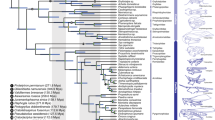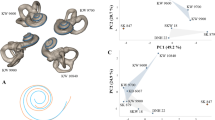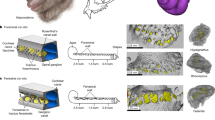Abstract
Ears of modern insects occur on a wide variety of body parts and are thought to have evolved from ubiquitous stretch or vibration receptors1,2,3,4. This relationship, based on comparative anatomy and similarities in the embryological development of ears in divergent taxa5,6,7, has led to the widespread assumption of homology of these structures in insects, although this has not been tested rigorously. Here we report on the hearing organs of a relatively ancient8, atympanate bladder grasshopper9,10,11 (Bullacris membracioides), which is capable of signalling acoustically over ∼2 km12. We show that, within single individuals of this species, serially repeated abdominal ears show functional continuity from simple to more complex forms. All 12 morphologically differentiated organs respond to sound frequencies and intensities that are biologically significant, and mediate adaptive behavioural responses. By linking observations at the anatomical, physiological and behavioural level, our experiments provide evidence for the transition in function and selective advantage during the evolutionary development of this complex structure13,14. It is possible that ancestral insects with only simple pleural receptors had auditory capability covering distances substantially greater than contemporary insects with tympanate ears.
This is a preview of subscription content, access via your institution
Access options
Subscribe to this journal
Receive 51 print issues and online access
$199.00 per year
only $3.90 per issue
Buy this article
- Purchase on Springer Link
- Instant access to full article PDF
Prices may be subject to local taxes which are calculated during checkout



Similar content being viewed by others
References
Boyan, G. S. Another look at insect audition: the tympanic receptors as an evolutionary specialization of the chordotonal system. J. Insect Physiol. 39, 187–200 (1993).
Fullard, J. H. & Yack, J. E. The evolutionary biology of insect hearing. Trends Ecol. Evol. 8, 248–252 (1993).
Hoy, R. R. & Robert, D. Tympanal hearing in insects. Annu. Rev. Entomol. 41, 433–450 (1996).
Shaw, S. R. Detection of airborne sound by a cockroach ‘vibration detector’: a possible missing link in insect auditory evolution. J. Exp. Biol. 193, 13–47 (1994).
Meier, T. & Reichert, H. Embryonic development and evolutionary origin of the Orthopteran auditory organs. J. Neurobiol. 21, 592–610 (1990).
Yack, J. E. & Roots, B. I. The metathoracic wing-hinge chordotonal organ of an atympanate moth Actias luna (Lepidoptera, Saturniidae): a light- and electron-microscopic study. Cell Tissue Res. 267, 455–471 (1992).
Yack, J. E. & Fullard, J. F. The mechanoreceptive origin of insect tympanal organs: a comparative study of similar nerves in tympanate and atympanate moths. J. Comp. Neurol. 300, 523–534 (1990).
Flook, P. K. & Rowell, C. H. F. The phylogeny of the Caelifera (Insecta, Orthoptera) as deduced from mtrRNA gene sequences. Mol. Phylogenet. Evol. 8, 89–103 (1997).
Dirsh, V. M. Revision of the Family Pneumoridae (Orthoptera: Acridoidea). Bull. Br. Mus. Nat. Hist. Entonol. 15, 325–396 (1965).
Alexander, A. J. The bladder grasshopper: a ‘nu-nu’ of mystery and intrigue. Afr. Wildl. 46, 261–262 (1992).
Alexander, A. & van Staaden, M. J. in Alternative Life-History Styles of Animals(ed. Bruton, M. N.) 261–277 (Kluwer, Dordrecht, (1989)).
van Staaden, M. J. & Römer, H. Sexual signalling in bladder grasshoppers: tactical design for maximizing calling range. J. Exp. Biol. 200, 2597–2608 (1997).
Robert, D., Amoroso, J. & Hoy, R. R. The evolutionary convergence of hearing in a parasitoid fly and its cricket host. Science 258, 1135–1137 (1992).
Yack, J. E. & Fullard, J. F. What is an insect ear? Ann. Entomol. Soc. Am. 86, 677–682 (1993).
Popov, A. V. Sound production and hearing in the cicada Cicadetta sinuatipennis Osh. (Homoptera, Cicadidae). J. Comp. Physiol. A 142, 271–280 (1981).
Bailey, W. J. & Römer, H. Sexual differences in auditory sensitivity: mismatch of hearing threshold and call frequency in a tettigoniid (Orthoptera, Tettigoniidae: Zaprochilinae). J. Comp. Physiol. A 169, 349–353 (1991).
Mason, A. C. Hearing in a primitive ensiferan: the auditory system of Cyphoderris monstrosa (Orthoptera: Haglidae). J. Comp. Physiol. A 168, 351–363 (1991).
Rheinlaender, J. & Römer, H. Insect hearing in the field I. The use of identified nerve cells as ‘biological microphones’. J. Comp. Physiol. A 158, 647–651 (1986).
Yager, D. D. & Spangler, H. G. Behavioural response to ultrasound by the tiger beetle Cincindela marutha dow combines aerodynamic changes and sound production. J. Exp. Biol. 200, 649–659 (1997).
Wiley, R. H. in Behavioral Mechanisms in Ecology(ed. Real, L. A.) 157–189 (Univ. Chicago Press, (1994)).
Hustert, R. Morphologie und Atmungsbewegungen des 5. Abdominalsegments von Locusta migratoria migratorioides. Zool. Jb. Physiol. 78, 157–174 (1974).
Meyer, J. & Hedwig, B. The influence of tracheal pressure changes on the responses of the tympanal membrane and auditory receptors in the locust Locusta migratoria L. J. Exp. Biol. 198, 1327–1339 (1995).
Strausfeld, N. J. & Miller, T. A. Neuroanatomical Techniques(Springer, New York, (1980)).
Rheinlaender, J. & Römer, H. Bilateral coding of sound direction in the CNS of the bushcricket Tettigonia viridissima L. (Orthoptera, Tettigoniidae). J. Comp. Physiol. A 140, 101–111 (1980).
Acknowledgements
We thank the Alexander family, B.-A. Gereben-Krenn, M. Rieser, H. Schuster, W.vanStaaden and R. Wright for assistance; A. Delago for help with experiments; C. Kernbichler, S. Ott, K.Steiner and Wirsam Scientific & Precision Equipment for technical assistance; the KwaZulu/Natal Parks Board for collecting permits; and G. Boyan, J. Fullard, R. Huber and D. Robert for comments. This research was supported by the Austrian Science Foundation.
Author information
Authors and Affiliations
Corresponding author
Rights and permissions
About this article
Cite this article
van Staaden, M., Römer, H. Evolutionary transition from stretch to hearing organs in ancient grasshoppers. Nature 394, 773–776 (1998). https://doi.org/10.1038/29517
Received:
Accepted:
Issue Date:
DOI: https://doi.org/10.1038/29517
This article is cited by
-
Neurophysiology goes wild: from exploring sensory coding in sound proof rooms to natural environments
Journal of Comparative Physiology A (2021)
-
Phylogenomic analysis sheds light on the evolutionary pathways towards acoustic communication in Orthoptera
Nature Communications (2020)
-
Innate releasing mechanisms and fixed action patterns: basic ethological concepts as drivers for neuroethological studies on acoustic communication in Orthoptera
Journal of Comparative Physiology A (2019)
-
Listening in the bog: II. Neural correlates for acoustic interactions and spacing between Sphagniana sphagnorum males
Journal of Comparative Physiology A (2018)
-
The complex tibial organ of the New Zealand ground weta: sensory adaptations for vibrational signal detection
Scientific Reports (2017)
Comments
By submitting a comment you agree to abide by our Terms and Community Guidelines. If you find something abusive or that does not comply with our terms or guidelines please flag it as inappropriate.



